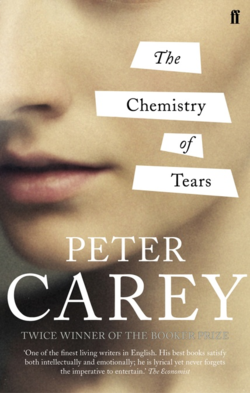
After I wrote here recently of how much I had enjoyed Peter Carey's Parrot and Olivier in America, a kind commenter suggested this one, which I had never so much as heard of (thanks, Alex!). It took me a while to get into it (which I also said about the last one) but but I soon got completely drawn in to the two extraordinary lives which, though separated by nearly 150 years, interweave in fascinating ways through this complex and subtle novel.
He told me that tears produced by emotions are chemically different from those we produce for lubrication. So my shameful little tissues, he said, now contained a hormone involved in the feeling of sexual gratification, another hormone that reduced stress, and finally, a very powerful natural painkiller.
Catherine Gehrig is a middle-aged horologist who works at a celebrated museum in south west London. At the very start of the novel, she learns that Matthew, her married lover of thirteen years, has died suddenly of a heart attack. This is doubly intolerable for her, as not only is she suffering from appalling grief, but she also has to conceal the fact from everyone at work apart from her boss, Eric Croft, who knows the truth of the situation. A kind man, he decides to give her a project -- a complex mechanical toy has arrived and needs assembling. As well as the mutitude of parts, the packing cases prove to contain the notebooks of one Henry Branding, a wealthy Victorian responsible for commissioning the toy, which finally turns out to be an extraordinarily beautiful swan. Catherine, who is spending most of her time drunk, weeping or furious, is slowly drawn into Henry's story. The novel is told in sections, narrated alternately between Catherine and Henry.
Henry's story is indeed a rather extraordinary one. He has a beloved small son, Percy, who is suffering from what we take to be consumption. Henry has got the idea that to present him with this marvelous toy will in fact help to cure him, and he is so possessed with this idea that he sets off for Karlsruhe in the Black Forest to find one of the famous clock-makers who live there to manufacture the automaton. The one he ends up with is a bizarre giant of a man, Herr Sumpter, who Henry deeply mistrusts. Sumpter carries him off to his workshop in Furtwangen, where he meets the beautiful Frau Helga and her small son, Sumpter's assistant, the brilliant Carl.
Neither Catherine nor Henry are in the least likeable people. Both of them are deeply suspicious of everyone they have to deal with -- Catherine has been landed with Amanda Sneyd, a beautiful but mentally unstable girl assistant (who turns out to be the girlfriend of one of Matthew's sons), who she initially dislikes intensely, and Henry is so horrified and shocked by Sumpter's methods and attitude that he simply dismisses him as a cheat and liar, neither of which he actually is. But slowly, slowly, over time, these two damaged and angry people learn to trust and even to like (perhaps even love) their great antagonists.
For, among many other things, this is a novel about healing, and though Catherine's journey will be a long one, and though we never discover what happened to Henry's beloved Percy, there is a sense in which both protagonists have moved on considerably from their furious, anxious, desperate beginnings. It's also about perception -- Catherine is determined at first that the automaton is a monkey, then a duck, before she finally realises it is a swan. Henry is so blinkered that he actually fails to see physical things that are right in front of his eyes - as Sumpter explains, the human mind is incapable of seeing things it doesn't believe in the existence of. Henry is actually sometimes hilarious in his complete misunderstanding of everything that is going on around him, and as he softens and mellows, it's impossible not to be really rooting for the success of his absolutely mad venture. As for Catherine, it is certainly cheering to find her able to enjoy the unveiling of the swan and to hope that through Amanda and her boyfriend she may find some kind of comfort in the future.
Peter Carey, as I'm sure I've said before, is a truly remarkable writer. He has a new novel coming out in November for which I'm on the review-copy list, so I'm really looking forward to that. Meanwhile I think I shall be rooting around a bit more in his back catalog. This one, I hardly need to say, is highly recommended.
